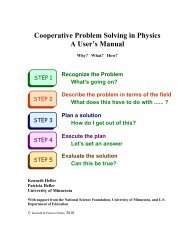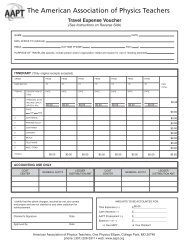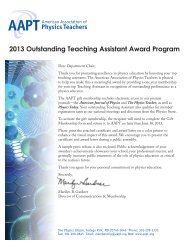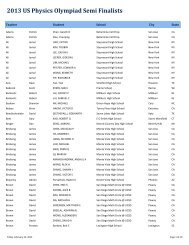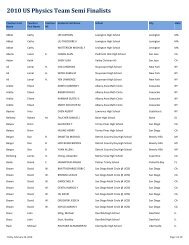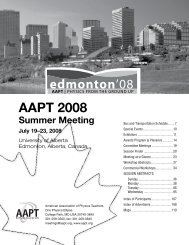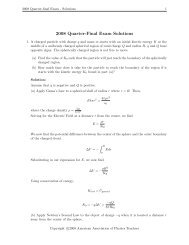Solution - American Association of Physics Teachers
Solution - American Association of Physics Teachers
Solution - American Association of Physics Teachers
You also want an ePaper? Increase the reach of your titles
YUMPU automatically turns print PDFs into web optimized ePapers that Google loves.
2013 F = ma Exam 1517. Two small, equal masses are attached by a lightweight rod. This object orbits a planet; the length <strong>of</strong> the rod issmaller than the radius <strong>of</strong> the orbit, but not negligible. The rod rotates about its axis in such a way that it remainsvertical with respect to the planet.• Is there a force in the rod? If so, is it tension or compression?• Is the equilibrium stable, unstable, or neutral with respect to a small perturbation in the angle <strong>of</strong> therod? (Assume this perturbation maintains the rate <strong>of</strong> rotation, so that in the co-rotating frame the rodis still stationary but at an angle to the vertical.)(A) There is no force in the rod; the equilibrium is neutral.(B) The rod is in tension; the equilibrium is stable.(C) The rod is in compression; the equilibrium is stable.(D) The rod is in tension; the equilibrium is unstable.(E) The rod is in compression; the equilibrium is unstable.<strong>Solution</strong>Because the gravitational force goes as 1/r 2 , the inward force on the inner mass is greater than the inwardforce on the outer mass. On the other hand, both masses have the same angular velocity, so the centripetalacceleration goes as r, and the outer mass must be subject to a greater centripetal force than the inward one.So the rod must exert an inward force on the outer mass and an outward force on the inner mass. Thus therod is in tension.The stability <strong>of</strong> the position is best understood in the corotating frame. In this frame the outer massexperiences an outward radial force and the inward tension <strong>of</strong> the rod, and the inner mass experiences aninward radial force and the outward tension <strong>of</strong> the rod. When the rod is rotated slightly these forces createa restoring torque, so the equilibrium is stable.Copyright c○2013 <strong>American</strong> <strong>Association</strong> <strong>of</strong> <strong>Physics</strong> <strong>Teachers</strong>





